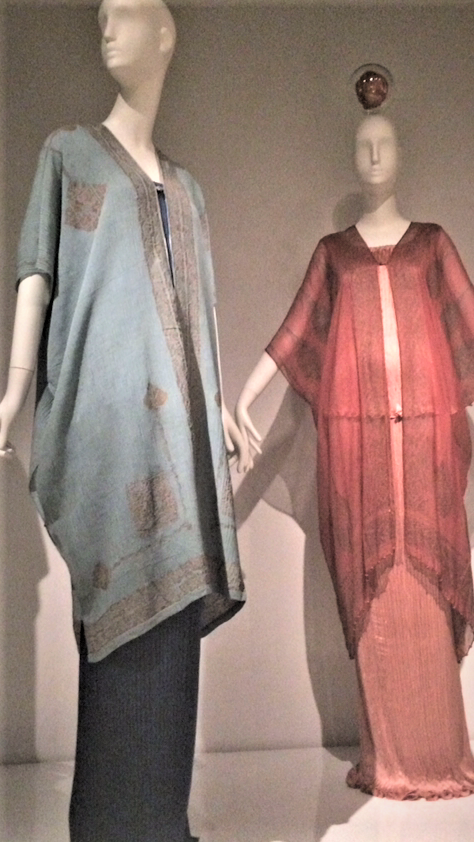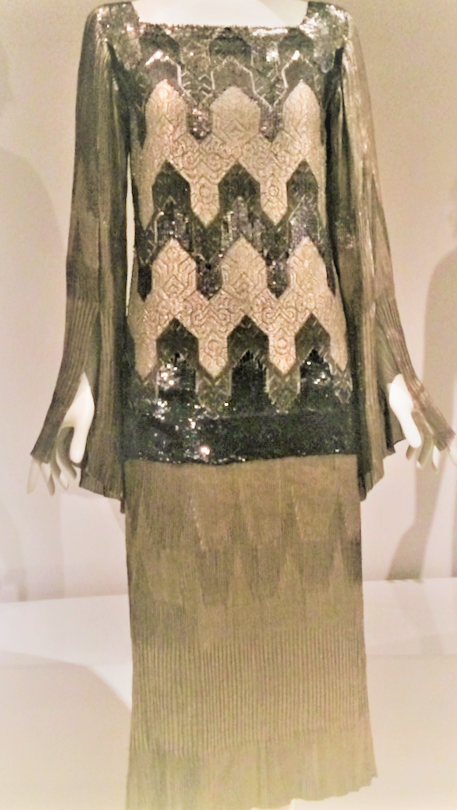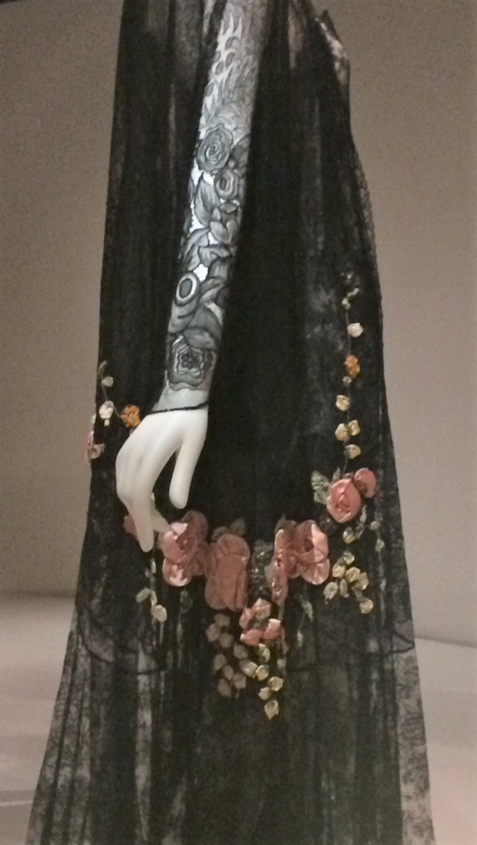In Pursuit of Fashion: The Sandy Schreier Collection at the Met
The whimsical hat is a curatorial after-thought
Sandy Schreier, a fashion historian and a lifelong collector of couture fashion, describes herself as a “fashion savior.” From her earliest years, even as a four-year-old, high fashion has been (and remains) a source of beauty for her, each item a work of art.
“Without me these objects would be thrown out, but I feel they are an art form that should be saved for future generations,” she said.
If you should be fortunate enough to see “In Pursuit of Fashion: The Sandy Schreier Collection,” I think you’ll agree she’s been an incredible advocate for lost craftsmanship and evolving textiles, amassing in a lifetime more than 15,000 items, an assemblage thought to be the ‘most valuable fashion collection in the world’. The ‘items’ include not only gowns and dresses, but shoes and bags and lingerie and fashion sketches, some of which you can see on the wall behind the mannequin.
What’s The Connection with the Met?
Over the years, Schreier has had an on-going relationship with the museum, lending many pieces from her collection for inclusion in other exhibits at the Costume Institute. And of late, 165 of these pieces have been promised to the Metropolitan Museum of Art, of which eighty are currently on display. Schreier is delighted with the arrangement, as is the Met, for she feels that now these Art Deco creations will be seen by millions and protected for eternity. Exquisite pieces that come not only from the iconic houses of Dior and Balenciaga, of Fortuny, Poiret, and Chanel, but from lesser-known designers whose gowns and dresses proved equally enchanting.
What’s Art Deco style?
About that I could ramble on for an hour, but for a succinct definition, I went to the web: “Art Deco, short for Arts Décoratifs, is characterized by rich colors, bold geometry, and detail work. Having reached the height of its popularity in the 1920s, '30s, and '40s, the style still brings in glamour, luxury, and order with symmetrical designs in exuberant shapes.”
When you think of Art Deco, think of the Chrysler Building (1928) with its regal crown, a catch-your-breath sight after all these years. Or the elegant Empire State Building (1931) completed within thirteen months, a feat never again duplicated. Or the Waldorf-Astoria, an Art Deco gem (1931) whose iconic interiors have recently been land-marked to protect them from demolition as the building is undergoing a three-year renovation, some floors being converted to condos. I, for one, breathe a sigh of relief knowing Peacock Alley will once again be available for a late afternoon drink or an early morning espresso. And, of course, there’s the sine qua non, Rockefeller Center (1939), famous for the harmony and beauty of its nineteen Art Deco commercial buildings, for the astonishing murals and art work, the vast underground concourse, the ice-skating rink where Prometheus keeps an eye on wobbly skaters, and for the annual lighting of the Christmas tree attended by thousands. And there you have it—Art Deco principles at work, still speaking to us of modernism and wealth and sophistication.
What’s SO Special about An Art Deco Dress?
At the bottom of the staircase in the far reaches of the Met leading to the Costume Institute, there’s a show-stopper, a square-necked crepe de chine gown of coral and gold metallic threads created by Madeleine and Madeleine, a leading haute-couture house in Paris between the Wars, 1919-1939. Madeleine Vionnet, who was known as the “Queen of the Bias Cut,” inspired all those slinky sexy gowns and dresses worn by Hollywood stars in the thirties and forties. What she knew early on was that cutting fabric on a bias allows the fabric to drape the body, to cling to the curves. Historians tell us that this 1923 dress by Madeleine and Madeleine with its scarab-inspired embroidery reflects the Egyptomania that swept the world following the discovery of the tomb of Tutankhamen in 1922.
It really does date the dress, doesn’t it? Would you wear it? I would.
Likewise there are exquisite pieces, for instance, by Boué Soeurs, a French fashion house founded in 1899 and famed in the1920s for their delicate lingerie and evening dresses featuring metallic threads and exquisite embroidery, which can be seen in the black Chantilly lace peignoir set, circa 1930 (see above right). The closest I’ve come to such a beauty is a chiffon peignoir by Josie Natori with voluptuous red flowers on a black background trimmed with Chantilly lace, if lacking the embroidery.
And What of the House of Chanel?
From the Legendary House of Gripoix in Paris
Part of the enduring legacy of Gabrielle Chanel is her championing of costume jewelry, something all of us take for granted nowadays. Included in the exhibit is a necklace fashioned in 1938, epitomizing the romantic ideal of the era favoring back-to-nature motifs; hence the flowers made of red, green and yellow glass created for Chanel by Maison Gripoix, founded in Paris in 1869 and famous for its own advocacy of costume jewelry.
Where Did Schreier’s Passion Come From?
As a very young child, Ms. Schreier often accompanied her father, a furrier at Russeks Department Store in Detroit, to work. There she showed an early interest in the dresses worn by his well-to-do clients, many of whom would bring in their castoffs for her to play with. They were as amused and delighted by the interest shown by this child in haute-couture, as she was by their clothes, some of which were worn only once. These women, wives of head-honchos at the all-important automotive companies in Detroit, were regular clients of the Paris haute couture and of the finest American designers. Assuredly, the ‘castoffs’ are treasures. According to Schreier, she always saw the clothes as works of art and treated them accordingly, never wearing a one.
Unlike Schreier, I’m no fashionista, far from it, but you need not be one to enjoy and appreciate this exhibit. Though I do regret missing her appearance at the Met by a day. “You should have been here yesterday,” said the guard.
Thirteen years in the making, the exhibit with its sylphlike graceful dresses is an antidote to a moment when fashion seems to be all about voluminous excess. Weeks ago, at the 92nd Academy Awards I spotted a Gucci gown that was too much of a good thing with silk duchesse-waist ruffles atop a flowing moiré skirt. E-gads. Then, too, there was a Louis Vuitton dress with not two or three but eight tiers of ruffles, to say nothing of the multitude of thigh-high slits and the surplus of cleavage. It all spoke of excess. And then during New York Fashion Week, a formal gown with puffy Gibson Girl sleeves and a ten-foot wide voluminous skirt outdoing anything ever worn by Marie Antoinette sauntered down the runway. Elegance requires restraint.
“In Pursuit of Fashion: The Sandy Schreier Collection,” runs until May 17th, 2020. Don’t miss this trip down memory lane.
That’s all for this week Gals and Guys…maybe next week you can join me at my new hideaway: Sant Ambroeus has opened a charming café on the ground floor of Sotheby’s on York Avenue. Until we meet again, may life be good to you. And if you have a second, remember sharing is caring.







